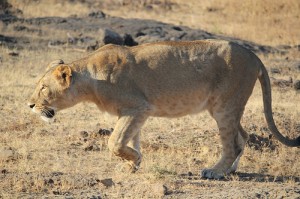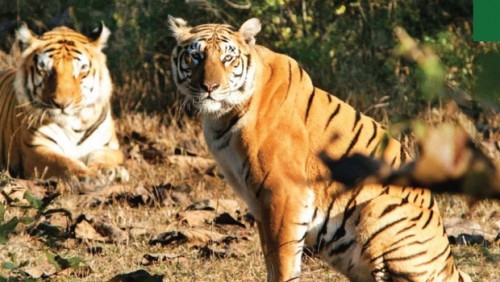CONSERVATION: Four years ago the entire population of Asiatic Lions in India and the world was contained within 10,500 sq km in the state of Gujarat. But thanks to conservation efforts that have led to the gradual increase in the number of lions in the past few years, lion inhabited areas have doubled so much so that one third of the Suarashtra region in the state of Gujarat is now recognized lion territory –much beyond protected forest areas.
Saurashtra region of Gujarat includes 7 important districts. Junagadh, a part of Saurashtra is where Sasan Gir National Park is located – the last abode of the Asiatic Lion. But recent census by the state forest department has shown that the lion is no longer living in just the national park and has moved beyond the boundaries expanding its territory to 20,000 sq km as compared to 10,500 sq km in 2010.
The study was based on the frequent lion kills and compensation given to farmers. The forest officials found that there were 1500 villages in the region that had reported of a lion kill and thus the presence of the wild cat in the vicinity.
Lions frequently venture in these places to kill domestic or herbivorous animals with most of these villages in Junagadh, Amreli and few in Bhavnagar district.
Out of Space
Asiatic lion is the oft forgotten subspecies of the lions with the African lion frequently stealing the limelight. But there was once a time when this lion was found across the Indian subcontinent, Mediterranean and Middle East. Overhunting led to the decrease in the number of lions until in 1907 it was tragically revealed that just 13 lions remained in India.
While this extremely alarming figure might have been a deliberate attempt to deter royalty from further hunting the wild cats, in 1968 the first independent census in Gujarat state had put the number of lions to be 177.
Since then, concentrated and laudable efforts by the state has helped increase the lion population. The numbers have consistently grown from 284 in 1990 to 304 (1995), 327 (2000), 359 (2005) and 411 according to the last census held in 2010. It also helped in de-listing of the subspecies in the Red List of Threatened species in 2012 by International Union for Conservation of Nature. (Read it here) From being marked Critically Endangered (CR), the Asiatic Lion is now marked Endangered (EN)
The downside of the rise in population has been that the lions on the lookout for new territories are rapidly expanding the area they inhabit, resulting in doubling the territory in just four years.
Officials believe there are 114 lions at present out of the 411 counted in 2010 that live outside the known lion territories. It is only the 2015 lion population census though that would ascertain the exact number and expanded habitat of the mega predator.
Sandeep Kumar, deputy conservator of forests, who conducted the study, says, “The study does not take into account stray kills. We have identified areas where the lion presence has been continuous over longer periods.”
From tigers and leopards, to elephants and now lions, will 2014 be the year when India faces its greatest conservation challenge of finding space to accommodate all its animals and people? While conservationists and strategists continue to look for better ways to avoid human-animal conflict over land, the king continues to conquer newer territories which is his natural instinct.
More About Asiatic Lion
Common Name – Asiatic Lion, Asian Lion, Indian Lion, Singh (Hindi), Babbar Sher (Hindi)
Scientific Name – Panthera leo persica
IUCN Status – Endangered (EN)
Fast Facts
- Asiatic lions are genetically distinct from the lions of sub-Saharan Africa, although the difference is not large.
- Asiatic lions have a smaller pride size than their African cousins. Their prides have an average of only two females, whereas an African pride has an average of four to six.They are also smaller built.
- They have belly fold and distinctive tuft of hair on elbow which are absent in their Afican counterparts.
- They predominantly prey on deer (sambar & chital), antelope (nilgai), wild boar, and livestock.
- The Asiatic lion currently exists as a single subpopulation, and is thus vulnerable to extinction from unpredictable events, such as an epidemic or large forest fire.
More Related Stories,
Rise in Livestock Numbers Once Again a Problem at Gir
Lion Bones now Substitute for Tiger Bones in Traditional Medicine
12 Gir Lions to get a New Home in Kuno
Image via CC/Flickr by Arian Zwegers






Animals do NOT stray. Animals move because of very specific reasons. There are ecological and behavioural reasons for the movement of animals and we need to recognise and understand these. By terming this as ‘straying’ our solutions are to either to prevent ‘straying’ often in the form of barriers or to capture and release the animals back in what we think are their ‘homes’ both of which are approaches that almost always will fail. Animals do not need traffic signs to guide their movement. Sites like yours which are focussing on wildlife and conservation should be careful and accurate with the language that is used.
Thank you for your valuable feedback. This article is from 2014 and the narrative was then based on the research and the language used by the forest department and the reference to ‘straying’ of animals. Your point is absolutely right. Animals are not straying, it is humans who have drawn the lines of ‘protected’ and ‘non-protected’areas and assumed that wildlife will follow these guidelines.
Nevertheless, the issue at the core is lion territory is expanding and there is greater urgency to find safe habitats for them beyond that designated as a protected area right now.